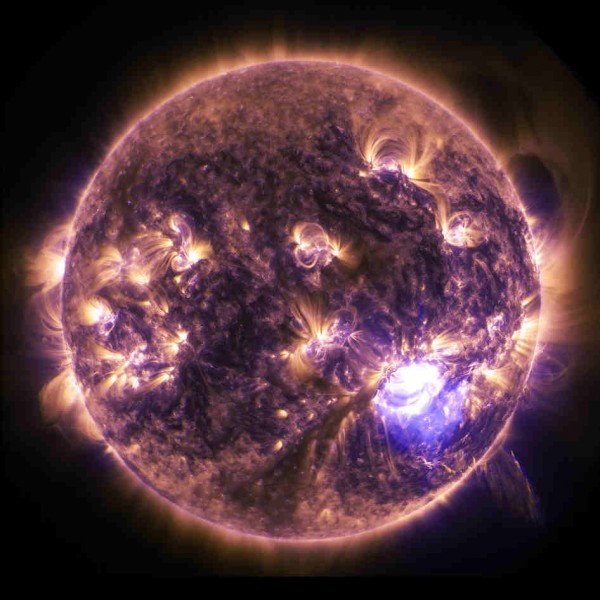The Sun Lights-up the Sky with Solar Flares
| Ana Verayo | | Dec 23, 2014 06:55 AM EST |
(Photo : NASA/SDO) The sun emitted a significant solar flare, peaking at 7:28 p.m. EST on Dec. 19, 2014.
The Sun seems like it's displaying a lot of holiday lights just in time for the Christmas season as eruptions cause a massive surge in solar activity starting last Friday.
NASA considers this solar activity significant since it peaked into a brilliant display of X1.8-class flares sometime around 7:28 EST Friday night.
Like Us on Facebook
According to the space agency, harmful radiation from the solar flare can't enter the Earth's atmosphere to affect us. But when the flares are intense enough, they can disturb the atmosphere, disrupt GPS and telecommunication signals.
This stunning holiday flare was a potentially dangerous wave of solar activity. X-class solar flares are classified as the most powerful ones. The 1.8 means this specific flare is rather small to medium in its class.
X3 flares are three times as powerful as an X1 solar flare and an X1 solar flare will be significantly stronger than any kind of M-class flare, which is notorious for causing small to medium blackouts and radiation storms.
These harmful flares can also release strong geomagnetic disturbances when these solar winds strike the Earth's magnetosphere. These auroras aren't only seen in the Northern Hemisphere but can also destroy magnetic navigation. Electrically charge ground induced currents can disturb power lines in underground cables.
Fortunately, this current flare, while beautiful, didn't cause any strong geomagnetic storm on the planet. The National Oceanic and Atmospheric Administration said there was no geomagnetic activity over the weekend and just minor solar activity since Monday.
These images captured by NASA's Solar Dynamics Observatory reveal the stunning imagery of the Sun's powerful solar flares that coincide with the festive holiday lights.
TagsNASA Reveals Holiday Lights on the Sun Via Solar Flares, NASA, NOAA, solar flares, sun holiday lights solar flares NASA
©2015 Chinatopix All rights reserved. Do not reproduce without permission
EDITOR'S PICKS
-

Did the Trump administration just announce plans for a trade war with ‘hostile’ China and Russia?
-

US Senate passes Taiwan travel bill slammed by China
-

As Yan Sihong’s family grieves, here are other Chinese students who went missing abroad. Some have never been found
-

Beijing blasts Western critics who ‘smear China’ with the term sharp power
-

China Envoy Seeks to Defuse Tensions With U.S. as a Trade War Brews
-

Singapore's Deputy PM Provides Bitcoin Vote of Confidence Amid China's Blanket Bans
-

China warns investors over risks in overseas virtual currency trading
-

Chinese government most trustworthy: survey
-

Kashima Antlers On Course For Back-To-Back Titles
MOST POPULAR
LATEST NEWS
Zhou Yongkang: China's Former Security Chief Sentenced to Life in Prison

China's former Chief of the Ministry of Public Security, Zhou Yongkang, has been given a life sentence after he was found guilty of abusing his office, bribery and deliberately ... Full Article
TRENDING STORY

China Pork Prices Expected to Stabilize As The Supplies Recover

Elephone P9000 Smartphone is now on Sale on Amazon India

There's a Big Chance Cliffhangers Won't Still Be Resolved When Grey's Anatomy Season 13 Returns

Supreme Court Ruled on Samsung vs Apple Dispute for Patent Infringement

Microsoft Surface Pro 5 Rumors and Release Date: What is the Latest?










